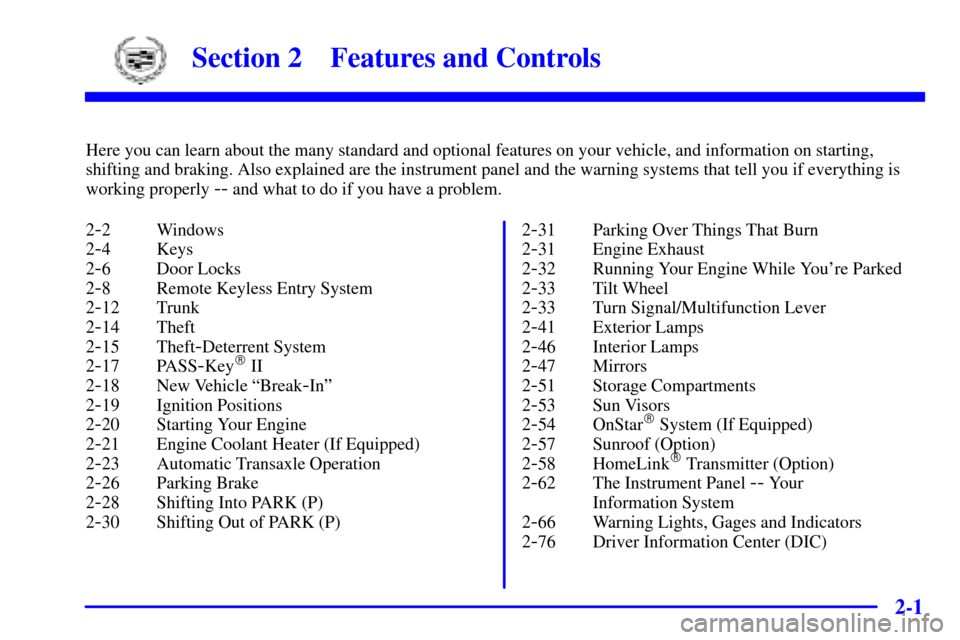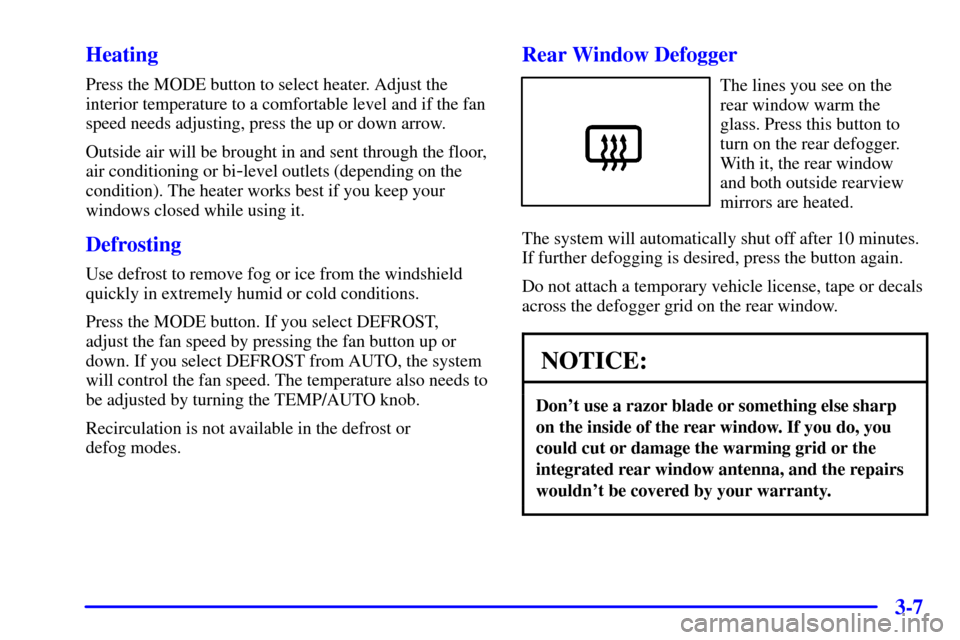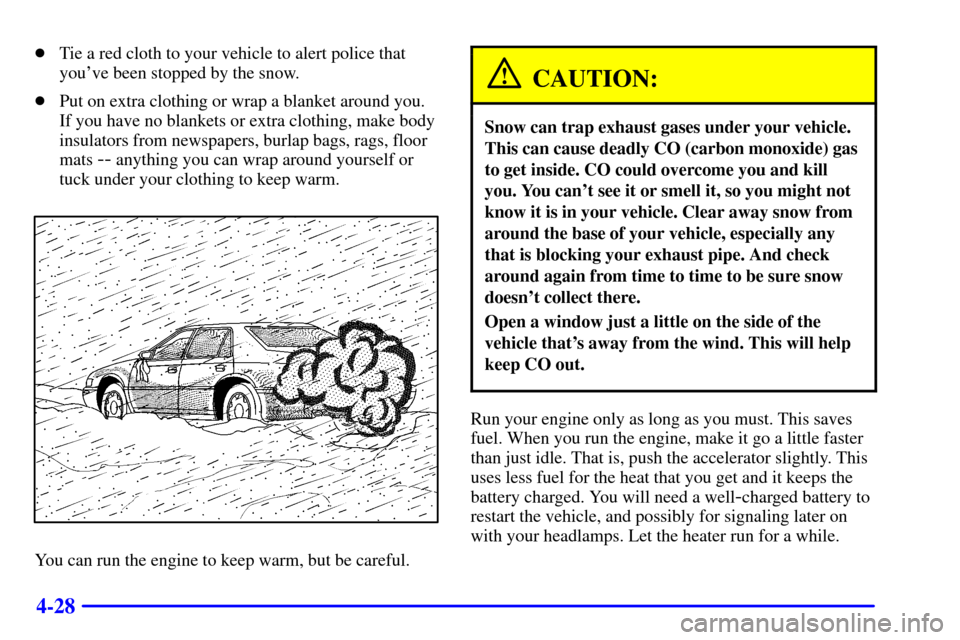Page 62 of 335

2-
2-1
Section 2 Features and Controls
Here you can learn about the many standard and optional features on your vehicle, and information on starting,
shifting and braking. Also explained are the instrument panel and the warning systems that tell you if everything is
working properly
-- and what to do if you have a problem.
2
-2 Windows
2
-4 Keys
2
-6 Door Locks
2
-8 Remote Keyless Entry System
2
-12 Trunk
2
-14 Theft
2
-15 Theft-Deterrent System
2
-17 PASS-Key� II
2
-18 New Vehicle ªBreak-Inº
2
-19 Ignition Positions
2
-20 Starting Your Engine
2
-21 Engine Coolant Heater (If Equipped)
2
-23 Automatic Transaxle Operation
2
-26 Parking Brake
2
-28 Shifting Into PARK (P)
2
-30 Shifting Out of PARK (P)2
-31 Parking Over Things That Burn
2
-31 Engine Exhaust
2
-32 Running Your Engine While You're Parked
2
-33 Tilt Wheel
2
-33 Turn Signal/Multifunction Lever
2
-41 Exterior Lamps
2
-46 Interior Lamps
2
-47 Mirrors
2
-51 Storage Compartments
2
-53 Sun Visors
2
-54 OnStar� System (If Equipped)
2
-57 Sunroof (Option)
2
-58 HomeLink� Transmitter (Option)
2
-62 The Instrument Panel -- Your
Information System
2
-66 Warning Lights, Gages and Indicators
2
-76 Driver Information Center (DIC)
Page 82 of 335
2-21
2. If it doesn't start within 10 seconds, hold your key
in START for about 10 seconds at a time until
your engine starts. Wait about 15 seconds between
each try.
3. If your engine still won't start (or starts but then
stops), it could be flooded with too much gasoline.
Try pushing your accelerator pedal all the way to the
floor and holding it there as you hold the key in
START for about three seconds. If the vehicle starts
briefly but then stops again, do the same thing.
NOTICE:
Your engine is designed to work with the
electronics in your vehicle. If you add electrical
parts or accessories, you could change the way
the engine operates. Before adding electrical
equipment, check with your dealer. If you don't,
your engine might not perform properly.
Engine Coolant Heater (If Equipped)
A. Engine Oil Dipstick Location
B. Engine Coolant Heater Cord
C. Transaxle Dipstick/Fluid Fill Location
Page 83 of 335

2-22
In very cold weather, 0�F (-18�C) or colder, the engine
coolant heater can help. You'll get easier starting and
better fuel economy during engine warm
-up. Usually,
the coolant heater should be plugged in a minimum of
four hours prior to starting your vehicle.
To Use the Engine Coolant Heater
1. Turn off the engine.
2. Open the hood and unwrap the electrical cord.
The electrical cord is located on the driver's side of
the engine, behind the transaxle dipstick/fluid fill
location (C) and next to the engine.
3. Plug it into a normal, grounded 110
-volt AC outlet.
CAUTION:
Plugging the cord into an ungrounded outlet
could cause an electrical shock. Also, the wrong
kind of extension cord could overheat and cause
a fire. You could be seriously injured. Plug the
cord into a properly grounded three
-prong
11 0
-volt AC outlet. If the cord won't reach, use a
heavy
-duty three-prong extension cord rated for
at least 15 amps.
4. Before starting the engine, be sure to unplug
and store the cord as it was before to keep it away
from moving engine parts. If you don't, it could
be damaged.
How long should you keep the coolant heater plugged
in? The answer depends on the outside temperature, the
kind of oil you have, and some other things. Instead of
trying to list everything here, we ask that you contact
your dealer in the area where you'll be parking your
vehicle. The dealer can give you the best advice for that
particular area.
Page 156 of 335

3-4
If your vehicle is sitting out on a hot day and you have
it set on AUTO, the air will first flow out the floor air
outlets for a few seconds. That is normal. This is to
expel hot air from the air outlets. As the air is cooled,
the airflow will move through the air conditioning
outlets. If you start your vehicle with the fan setting
on HI, it will skip the air conditioning purge.
To avoid blowing cold air in cold weather, the system
will delay turning on the fan until warm air is available.
The length of delay depends on the outside air
temperature, engine coolant temperature or the time
since the engine was last started. As the coolant warms
up, the blower fan speed will gradually increase and air
will flow from the heater outlets, with some airflow
to the windshield to prevent fogging under most
normal conditions.
If you leave your vehicle, the system will remember the
control setting the next time you start your engine,
except for recirculation and defrost. Each ignition cycle
cancels recirculation, whereas, DEFROST will change
to automatic operation when the ignition is shut off and
then turned back on.Manual Operation
You may manually adjust the air delivery mode or
fan speed.
BI-LEVEL: This setting directs air into your
vehicle in two ways. Cool air is directed to the upper
portion of your body through the four instrument panel
outlets while warmed air is directed to the floor.
HEATER/DEFROST: This setting directs air
to the floor outlets and toward the windshield.
HEATER: This setting directs warmed air
through the floor outlets. Some warm air is diverted to
the windshield to minimize fogging.
DEFROST: Press this button to quickly remove
fog or frost from the windshield. This setting sends
most of the airflow to the windshield with only a small
amount to the floor outlets.
Page 159 of 335

3-7 Heating
Press the MODE button to select heater. Adjust the
interior temperature to a comfortable level and if the fan
speed needs adjusting, press the up or down arrow.
Outside air will be brought in and sent through the floor,
air conditioning or bi
-level outlets (depending on the
condition). The heater works best if you keep your
windows closed while using it.
Defrosting
Use defrost to remove fog or ice from the windshield
quickly in extremely humid or cold conditions.
Press the MODE button. If you select DEFROST,
adjust the fan speed by pressing the fan button up or
down. If you select DEFROST from AUTO, the system
will control the fan speed. The temperature also needs to
be adjusted by turning the TEMP/AUTO knob.
Recirculation is not available in the defrost or
defog modes.
Rear Window Defogger
The lines you see on the
rear window warm the
glass. Press this button to
turn on the rear defogger.
With it, the rear window
and both outside rearview
mirrors are heated.
The system will automatically shut off after 10 minutes.
If further defogging is desired, press the button again.
Do not attach a temporary vehicle license, tape or decals
across the defogger grid on the rear window.
NOTICE:
Don't use a razor blade or something else sharp
on the inside of the rear window. If you do, you
could cut or damage the warming grid or the
integrated rear window antenna, and the repairs
wouldn't be covered by your warranty.
Page 160 of 335
3-8 Ventilation System
Your vehicle's flow-through ventilation system supplies
outside air into the vehicle when it is moving. Outside
air will also enter the vehicle when the heater or the air
conditioning fan is running.
The front outlets are located in the center and at each
side of the instrument panel. You can adjust the
direction of airflow by moving the center control levers
or you can stop the airflow by moving the lever located
on each side of the outlets downward.
The direction of airflow for the rear seats can also be
adjusted. Move the fan lever to adjust the blower speed
from low to high. Move the vent lever to direct the airflow.
Page 161 of 335
3-9
Ventilation Tips
�Keep the hood and front air inlet free of ice, snow or
any other obstruction (such as leaves). The heater
and defroster will work far better, reducing the
chance of fogging the inside of the windows.
�When you enter a vehicle in cold weather, adjust the
fan to the highest speed for a few moments before
driving off. This helps clear the intake outlets of
snow and moisture, and reduces the chance of
fogging the inside of the windows.
�Keep the air path under the front seats clear of
objects. This helps circulate air throughout
your vehicle.HVAC Steering Wheel Controls
Some heating and cooling
controls can be adjusted at
the steering wheel. Other
touch controls operate some
audio controls. SeeªAudio
Steering Wheel Controlsº
in the Index.
FAN SPEED: Press the up arrow lever to
increase the fan speed and the down arrow lever to
decrease fan speed.
TEMP: Press the up arrow lever to increase
the temperature and the down arrow lever to
decrease temperature.
Page 215 of 335

4-28
�Tie a red cloth to your vehicle to alert police that
you've been stopped by the snow.
�Put on extra clothing or wrap a blanket around you.
If you have no blankets or extra clothing, make body
insulators from newspapers, burlap bags, rags, floor
mats
-- anything you can wrap around yourself or
tuck under your clothing to keep warm.
You can run the engine to keep warm, but be careful.
CAUTION:
Snow can trap exhaust gases under your vehicle.
This can cause deadly CO (carbon monoxide) gas
to get inside. CO could overcome you and kill
you. You can't see it or smell it, so you might not
know it is in your vehicle. Clear away snow from
around the base of your vehicle, especially any
that is blocking your exhaust pipe. And check
around again from time to time to be sure snow
doesn't collect there.
Open a window just a little on the side of the
vehicle that's away from the wind. This will help
keep CO out.
Run your engine only as long as you must. This saves
fuel. When you run the engine, make it go a little faster
than just idle. That is, push the accelerator slightly. This
uses less fuel for the heat that you get and it keeps the
battery charged. You will need a well
-charged battery to
restart the vehicle, and possibly for signaling later on
with your headlamps. Let the heater run for a while.